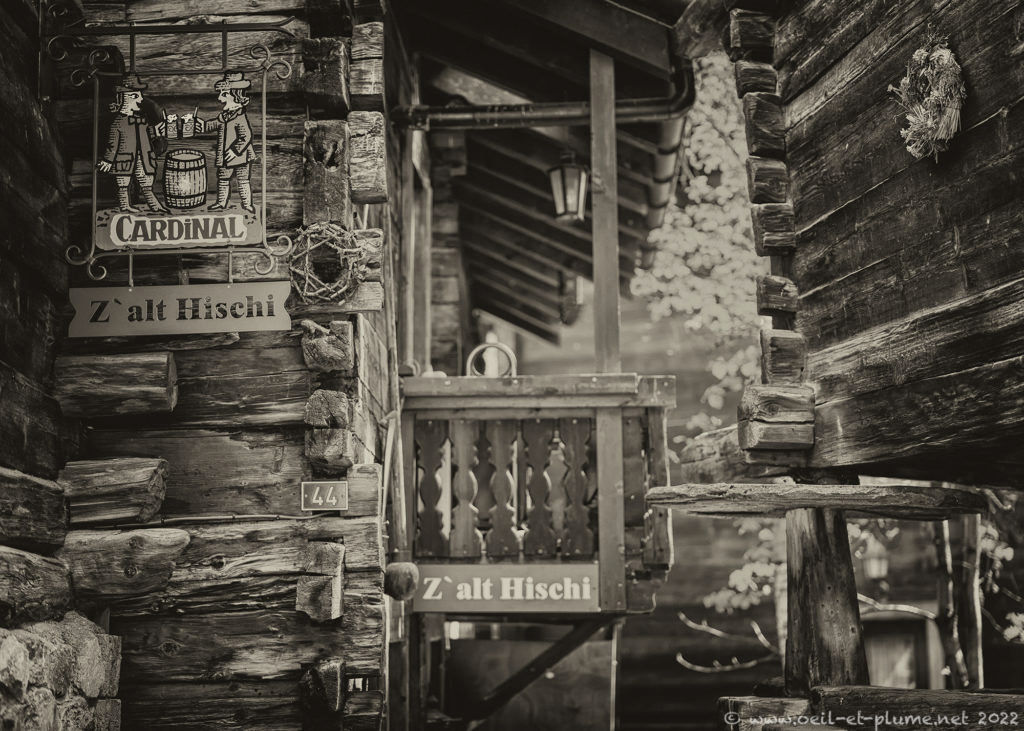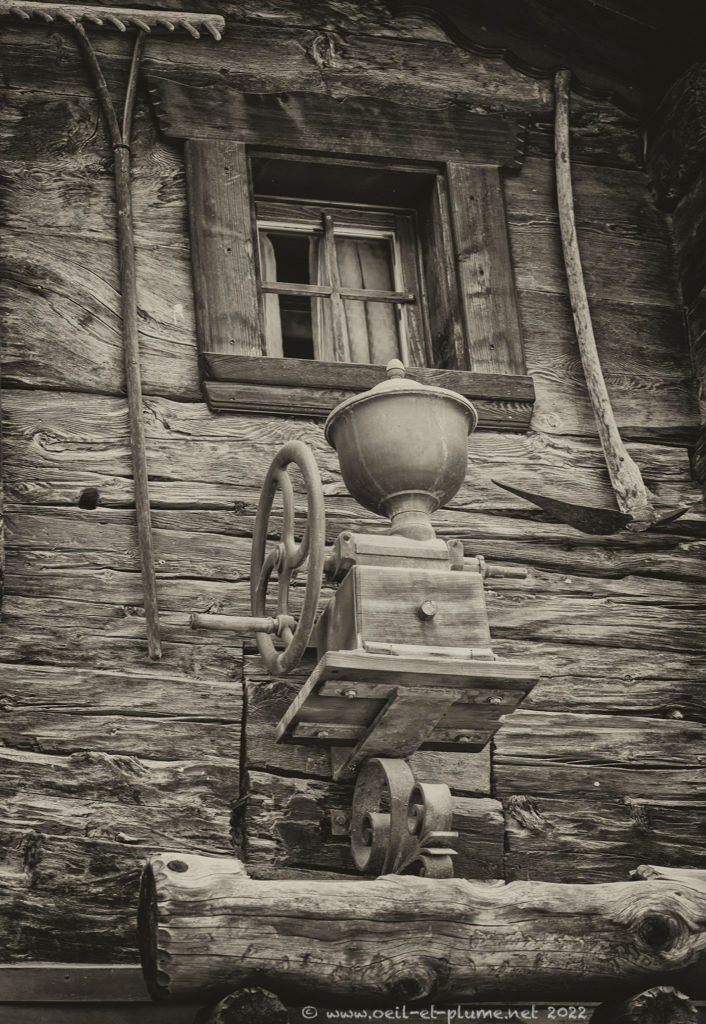I recently visited the Aletsch Glacier in my home region in the Swiss canton of Valais. Fed by four smaller glaciers, it is the largest glacier in the Alps. The imposing ice and snow pack negotiates nonetheless elegantly the landscape curves.
Like most glaciers in the world nowadays, the Aletsch glacier is unfortunately shrinking yearly. As of 2016, it had lost 3.2 kilometres in length and 300 meters in thickness compared to 1870. More recently, its length shrunk by 1.3 kilometre since 1980. In other words, the Aletsch glacier melting is not new but the phenomenon strongly accelerated in the last decades.
On my way down, my photographic eye is struck by a beautiful pyramidal mountain, standing on the other side of the Rhône valley. Icon of the Alps and world-wide celebrity, the Matterhorn lures me, using her magnetic attraction to recall me my alpinist years. Decades ago, I climbed numerous mountains in the Alps peaking above 4,000 meters, but not the Matterhorn.

Zermatt
It took only a few weeks until I visited Zermatt, located at the bottom of the Matterhorn. From the settlement centre, the free-standing rock pyramid stands not only closer but also more elusive and provocative to my eyes.
I bravely resisted the call of the pyramidal siren. Instead of climbing the Matterhorn, I tracked the mineral gem with my camera, at the risk of violating one my photographic mottos: avoid making postcard-like pictures and look instead for more creative subjects and perspectives. I did my very best to stick to my motto despite the stunning beauty of the Matterhorn.
Grown today to a famous mountain resort, Zermatt was only a small village at in the 19th century when the Matterhorn was climbed for the first time. A typical Alpine village, built essentially with local materials in a compact and dense settlement plan. Every square meter of flat land counts in the Alps. Well-preserved buildings in Zermatt’s historical centre help us sketching local life in ancient times.





Matterhorn’s magnetic attraction
Despite the vintage charm of the resort, I feel very attracted by the Matterhorn. Why is it so? Standing at 4,478 metres, the Matterhorn is only the sixth-highest summit in the Alps. Four of the neighbouring summits look at the Matterhorn from above, namely the Dufourspitze (4,634 m), the Dom (4,545 m), the Liskamm (4,527 m) and the Weisshorn (4,505 m).
The Matterhorn lures us through its harmonious pyramidal shape standing alone in an open mineral environment. The Matterhorn’s four faces nearly match the compass points. The northern, eastern and western faces are located in Switzerland, while the southern face is part of Italy. Only small patches of snow and ice cling to the steep faces of the mountain; most of the snow falls down to the bottom and feed the surrounding glaciers.

The Matterhorn is sometimes depicted as an African mountain. The formation of the Alps including the Matterhorn started 200 million years ago when the Pangaea continent split into Laurasia (containing Europe) and Gondwana (containing Africa). While the materials of the nearby Monte Rosa summit were formed in Laurasia, most of the Matterhorn’s rocks stem from Gondwana. Laurasia and Gondwana were then separated by the Tethys Ocean.
100 million years ago, the rocks forming today’s Matterhorn broke from Gondwana and joined the European continent. 50 million years later, as the rock masses folded and deformed, the Matterhorn was born from the rock thrusting upwards.
The Matterhorn’s pyramidal shape was carved more recently through natural erosion over the past million years. Initially, the Matterhorn was a rounded mountain like a hill. One can only congratulate the Nature for her exquisite chiselling work on the Matterhorn’s obelisk.
The Matterhorn’s pioneers
Mid-19th century, mountaineering activity flourished in the Alps, driven mainly by British alpinists and their Swiss and French guides. Many high summits of the Alps were climbed for the first time within a decade. The golden age of alpinism culminated with Edward Whymper’s ascent of the Matterhorn on 14 July 1865. The group included Whymper and another three Englishmen, accompanied by a French guide and two local guides. On the descent, four of them – three English climbers and the French guide – fell to their deaths.
On the same 14 July, an Italian group of climbers led by Jean-Antoine Carrel were openly competing with the British team to achieve the first ascent of the Matterhorn. Departing from Italy, they climbed through another itinerary but aborted their ascent. Only three days later, Jean-Antoine Carrel and another climber made another attempt and reached the summit from the Italian side.
Worth noting that Whymper met the Matterhorn first as artist and engraver. In 1860, a London publisher sent him to Zermatt to make sketches of the local mountains. He fell obviously under the charm of the pyramidal siren. The 14-July 1865 ascent of the Matterhorn was his eight attempt since 1860.
The fierce international competition over the first ascent of the Matterhorn in the mid-19th century did not spare the female climbers. In 1871, the British Lucy Walker became the first woman to reach the summit of the Matterhorn, followed a few weeks later by her US rival Meta Brevoort. Walker hastily arranged for and conducted her first ascent of the Matterhorn as soon as she heard about Brevoort’s plan to do so in the coming weeks.
Advised to walk in the mountains for medical reasons, Walker ended up as the most successful female mountaineer of her time. Before climbing the Matterhorn, she had achieved the first ascent of some 15 major Alps summits in the previous years, including the prestigious Eiger, Weisshorn and Grand-Combin in Switzerland, as well as the Aiguille Verte in France. On her side, Lucy Walker as both role model and rival. In contrast to Walker who always wore female dresses, Brevoort was the first female mountaineer in the Alps to wear trousers.
Amongst the three English climbers who died on the Matterhorn on 14 July 1865 was one Lord. Eventually, the then British Queen Victoria considered a ban to prevent more English noble blood to be spilled on the Matterhorn. In fact, her plan rather stimulated the interest of British alpinists vis-à-vis the iconic summit. In 1871, Whymper published a book about his first ascent, Scrambles Amongst the Alps, which turned into a world-wide bestseller.
In the following decades, the Alps mountaineering culture morphed further from pioneering age to modern times. The iconic Matterhorn entered the fields of popular art, commercial advertising and mass media. It inspired an abundant filmography until today. In parallel, modern alpinism developed gradually in Zermatt, particularly in relation to the Matterhorn.
The scramble to the Matterhorn
Beaten first 1865 by the Whymper’s team, the Matterhorn resisted hard further attempts to set foot on its top. The north face was climbed not before 1931, the west face only in 1962. Over time, climbers became bolder and bolder, adding multiple ascents and time constraints into their agenda. In 1966, two mountaineers climbed all four Matterhorn ridges in an enchainment within less than 24 hours. In 1992, two alpinists climbed the pyramidal rock up and down four times in less than 24 hours.

In more recent times, the scramble for the Matterhorn was brought to extraordinary levels with ultra-light extreme mountaineering. In 2013, the Spanish Catalan mountain runner Kilian Jornet reached the Matterhorn’s top from Breuil-Cervinia in less than two hours and completed the round trip in less than three hours. This was part of Jornet’s project aiming to set ascent and descent records for some of the highest summits on the planet. Initiated in 2010, the project culminated with the record attempt on the Mount Everest in 2017.
Fame comes often with a heavy price tag. Contemporary mass alpinism has made Matterhorn’s climbing only more complex and challenging. Up to 300 mountaineers embark daily into the ascent. Between 1865 and 2011, an estimated 500 climbers died on the Matterhorn. Unguided groups, the majority of the Matterhorn’s climbers, bear the heaviest toll. Poor and fast-changing weather also often undermine their safety. The Matterhorn is mainly composed of gneiss, often in derelict state. In recent years, the melting of the permafrost tends to increase rock falling along the climbing routes.
Back to my photography in Zermatt, I crisscrossed the Matterhorn’s surroundings in order to create my frames. Early dawn one day, I spotted deers which disappeared hastily in the woods. More importantly, I captured the first light rays on the eastern face of the iconic pyramid. There was no mass alpinism nor mass tourism there, only the Matterhorn and myself, which filled my soul with felicity.
Felicity often opens new appetite. A bit saturated by views from below, I feel the need to gain some altitude to gauge the mineral jewel straight in the eyes.
Gornergrat
Reachable from Zermatt by cog railway since the late 19th century already, the Gornergrat viewing platform stands at an altitude of over 3,000 meters. It allows breath-taking panoramic views on no less than 29 summits peaking above 4,000 m, including the Matterhorn.
I first turn my back to the Matterhorn to contemplate, from the left to the right, the Dufourspitze (4,634 m), the Liskamm, the Castor and Pollux sibling mountains, as well as the Breithorn.

The panorama is astonishing. Furthermore, a paraglider circles elegantly in the air above the Gornergrat glacier. Banking on thermic ascending air streams, he gains altitude to fade away in the horizon.

My close-ups of the Gornergrat glacier capture ice, snow and water – three states of a same natural element – composing elegant ephemeral sculptures adorned with moraines.

I finally face the Matterhorn. What a splendid piece of rock! I do not resist creating an iconic view of the iconic summit. This perspective on the Matterhorn was popularised also in the famous Toblerone chocolate bar.

Between you and me, I envy the one who dared biting the mountain’s ridges. I even dream now about setting my feet and my camera on the top of the rock pyramid one day. The Matterhorn lures, beware!
Cheers,











